Author: info@discoverdairy.com
Chocolate Candy Cane Milk Recipe

| This week, we have an easy Chocolate Candy Cane Milk recipe you can try with your students. The recipe seamlessly blends the rich allure of chocolate with the refreshing zing of a candy cane to create a drink that’s as indulgent as it is festive. |
| Ingredients (Milk) – 2 cups milk – 2 tablespoons chocolate syrup – 1/2 teaspoon peppermint extract Ingredients (Garnish) – 4 (3-inch) peppermint candy canes, divided – 2 tablespoons milk or semi-sweet chocolate chips – 1 teaspoon milk Directions 1. Using a pitcher, bowl, or container with a pour spout, combine milk, chocolate syrup and peppermint extract. Whisk or stir with a spoon until mixed. 2. Store covered in the refrigerator until ready to serve. 3. For the garnish, place two candy canes in a resealable plastic bag (or use one 6-inch candy cane) . Using a rolling pin or the bottom of a plastic cup, crush candy cane into small pieces. Pour crushed candy cane into a small shallow bowl. 4. In a separate bowl, combine chocolate chips and milk, microwave on high for 20 seconds. Stir melted chocolate until smooth (microwave for 10 more second if there’s still chocolate lumps). 5. For each serving, turn an 8-ounce drinking glass upside down and dip the rim first into the melted chocolate, then into the crushed candy cane. Place glasses in freezer for five minutes, then store in the refrigerator until serving time. 6. To serve, stir flavored milk mixture if it has been stored for more than five minutes. Divide mixture evenly between the two garnished glasses. Place one candy cane into each glass for stirring and enjoy. |
Dairy Fun Fact
At birth, a calf’s rumen (one of the 4 compartments in their stomach) is nonfunctional. As calves eat grain and hay during the first 5 months of life, a calf’s rumen grows at a rapid pace, faster than any other organ in their body!
Share this fun fact with your students as you introduce your Update 1 photos to them this week.
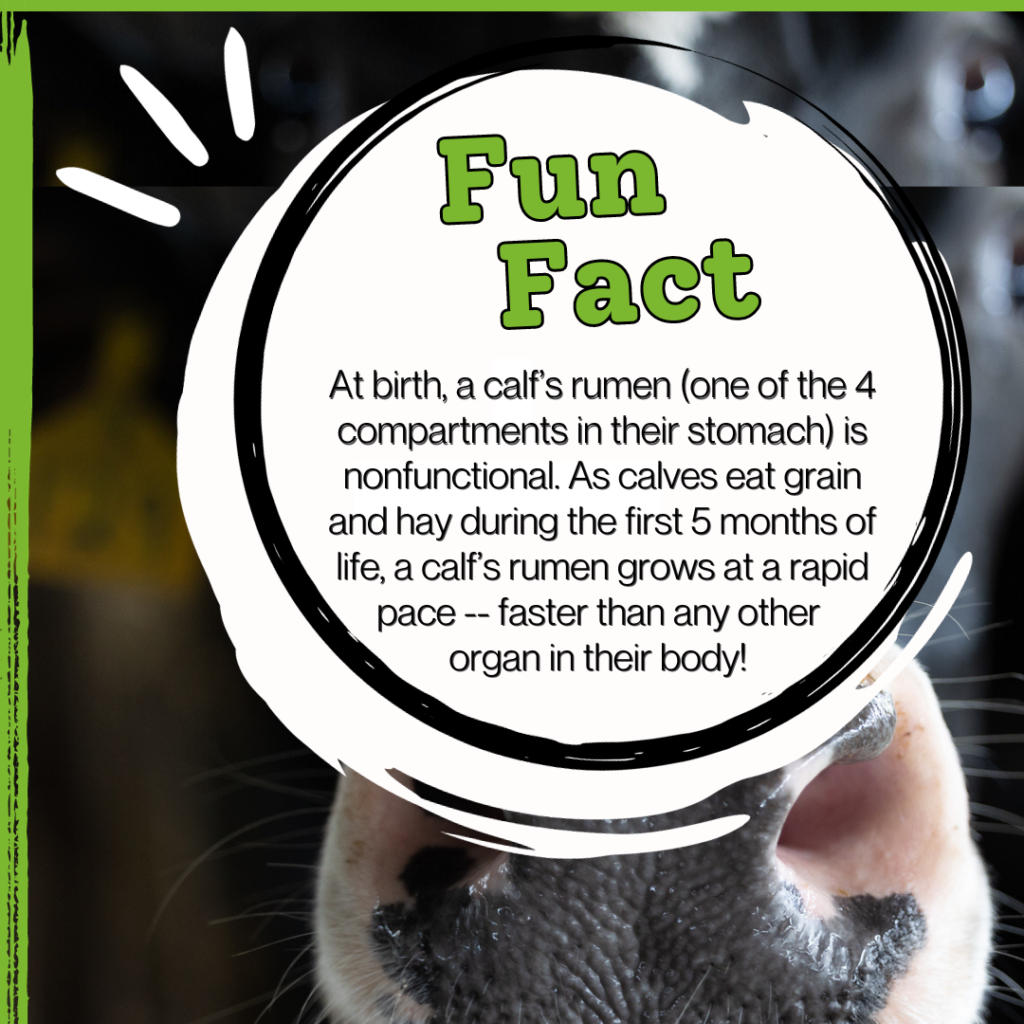
Join Farmer Harrison for a Virtual Farm Tour on December 22
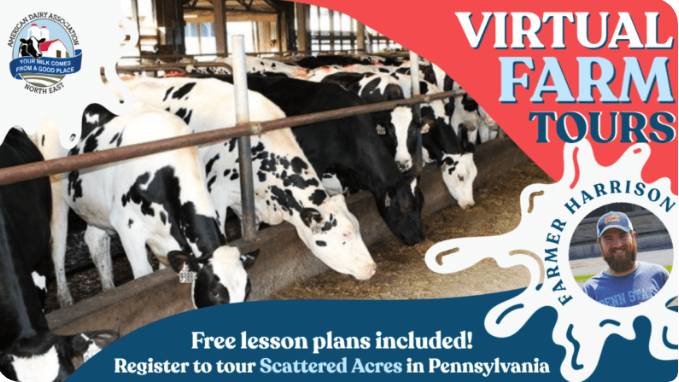
For a fun activity right before Christmas Break, you and your students are invited to American Dairy Association North East’s Virtual Farm Tour with Scattered Acres Dairy Farm and Farmer Harrison on Friday, December 22. The virtual tour includes three live stops: the cow barn, calf barn, and milking parlor to see how the whole farm works day to day.
Date: Friday, December 22, 2023
Time: 10 a.m. EST
Register: Click here to register.
Age group? This “deep dive” Farm Tour is ideal for grades 6-12.
Date: Friday, December 22, 2023
Time: 11:30 a.m. EST
Register: Click here to register.
Age group? This Farm Tour is ideal for grades pre-k to 5th grade.
12 Days of Dairy Holiday Activity Guide

As you and your students learn about dairy farming this school year, it’s time to get into the holi-dairy spirit with this Activity Guide! From crafts and recipes to a heartwarming movie, we encourage you to get creative and make these ideas your own. Want to start with Day Seven? Want to complete three activities in one day? There are no rules – just have fun with it! Don’t forget to tag Discover Dairy on social media to share your cow-themed holiday activities with us.
| Here are a few ideas included in the guide: – Homemade hot chocolate – Cow print marshmallows – Cow print hand ornament craft – Annabelle’s Wish holiday movie activity |
| Age group? These activities are ideal for students of all ages. |
The Art and Science of Cheese-Making
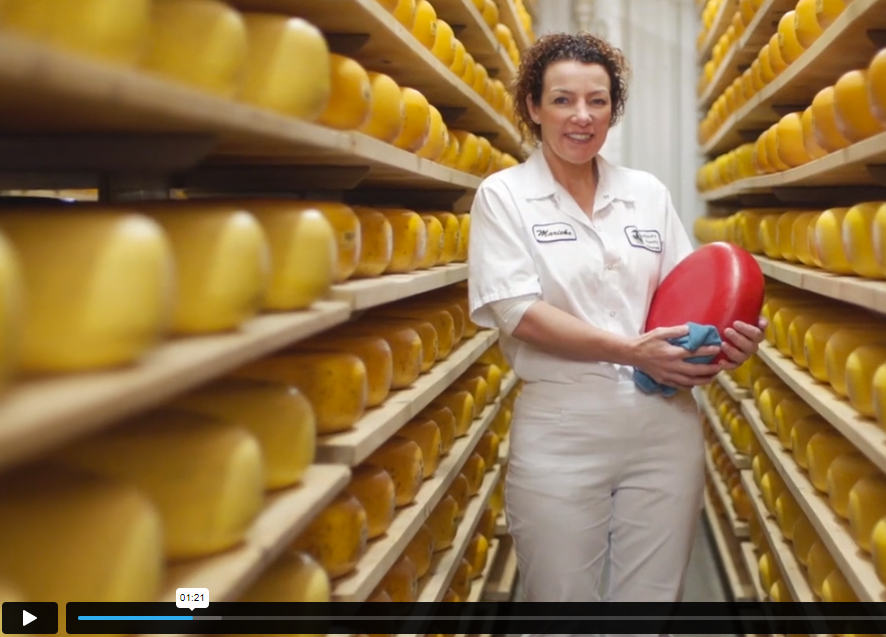
How is cheese made? Your students will learn the steps of cheese-making and the science behind it in this new video lesson from Dairy Farmers of Wisconsin. Learn how Wisconsin milk is transformed into award winning Wisconsin cheese! View the video and accompanying resources:
- Watch the Video – “The Art and Science of Cheese-Making”
- Cheese Science Toolkit
- Center for Dairy Research – Cheese Resources
Age group? These activities are ideal for high school students.
Eat Better Together This Holiday Season

Eating meals together is good for everyone, especially this holiday season. The time spent preparing and eating meals together supports physical, social, and emotional health for children and teens. This “Eat Better, Eat Together” Guide includes a range of fun ideas and recipes:
- Cook with Kids: If kids help prepare their meals, they are more likely to eat what they make and tend to be more adventurous eaters. There are plenty of fun recipes included in this guide.
- Add Dairy to Enhance Any Meal or Snack: The guide includes clever ways to add nutritious dairy products to common snacks/meals your students might eat.
- Dairy Hacks This Holiday Season: Out of sour cream? Substitute the same amount of plain Greek yogurt and enjoy the added protein. The guide includes several simple hacks like these!
Thanksgiving Kitchen Table Activity with “Farmers Fuel the World” Lesson

In this activity, your students can learn how their Thanksgiving food gets to their kitchen table sustainably. The hardworking farmers across the country are behind every piece of food they eat during the holiday season. What dairy products will they have during their meal? Encourage your students to talk to their family members and ask which dairy products are used in recipes for Thanksgiving. Students can make a list and report back when they return to school.
| To build on this idea, these “Farmers Fuel the World” lessons on FuelUpToPlay60.com will teach students about: > Environmentally sustainable agriculture practices that farmers use. > Food systems and how farmers use them to deliver food from farms to schools while caring for the environment. > Careers available throughout food systems in the U.S., including scientific, technological, and agricultural fields. |
| Age group? These lessons are ideal for high schoolers, but you can simplify them for elementary/middle school students with the Thanksgiving food activity above. |
Football & Thanksgiving: “Design Your Own Game Day Plan” Activity
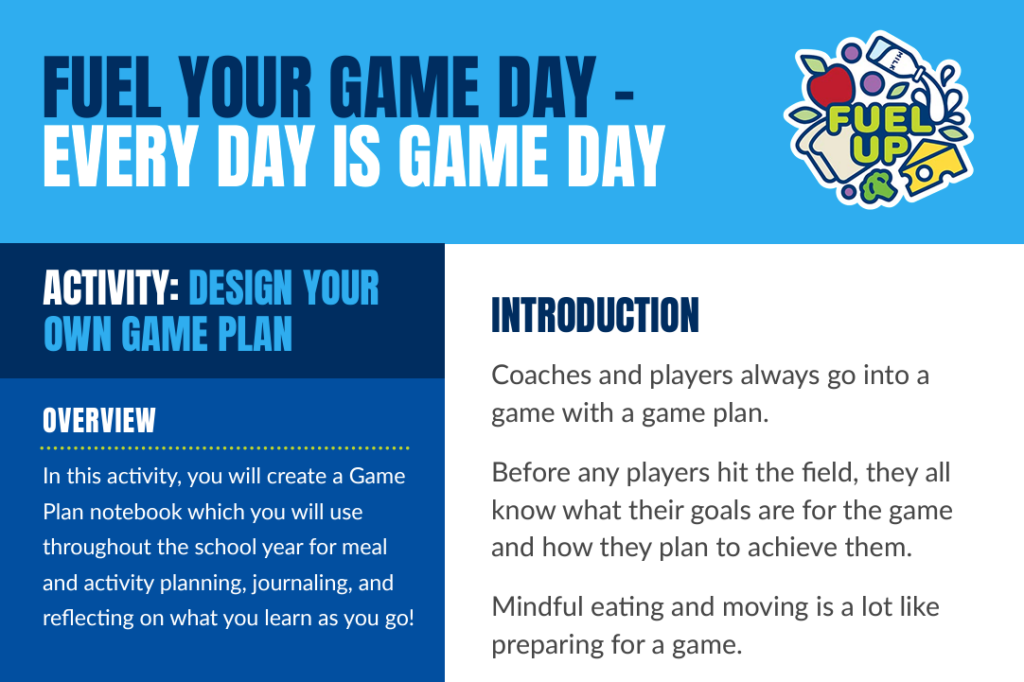
| Thanksgiving and football go hand in hand for a lot of families! Encourage your students to fuel their bodies this Thanksgiving with delicious food, and then get outside and active with their family (throw a football, go to the park or another activity)! In this “Fuel Your Game Day – Every Day Is Game Day” activity, it offers lessons focused on food as fuel for movement and associated activities, including the Design Your Own Game Plan Activity for students. Mindful eating and moving are a lot like preparing for a big game. By planning the four quarters of your day, students can create their own “game day plan” in this activity: – First Quarter: Breakfast -Second Quarter: School Day – Third Quarter: After School – Fourth Quarter: Family Time Age group? These activities are ideal for middle school students. |
Fun Fact: Cows and Pumpkins
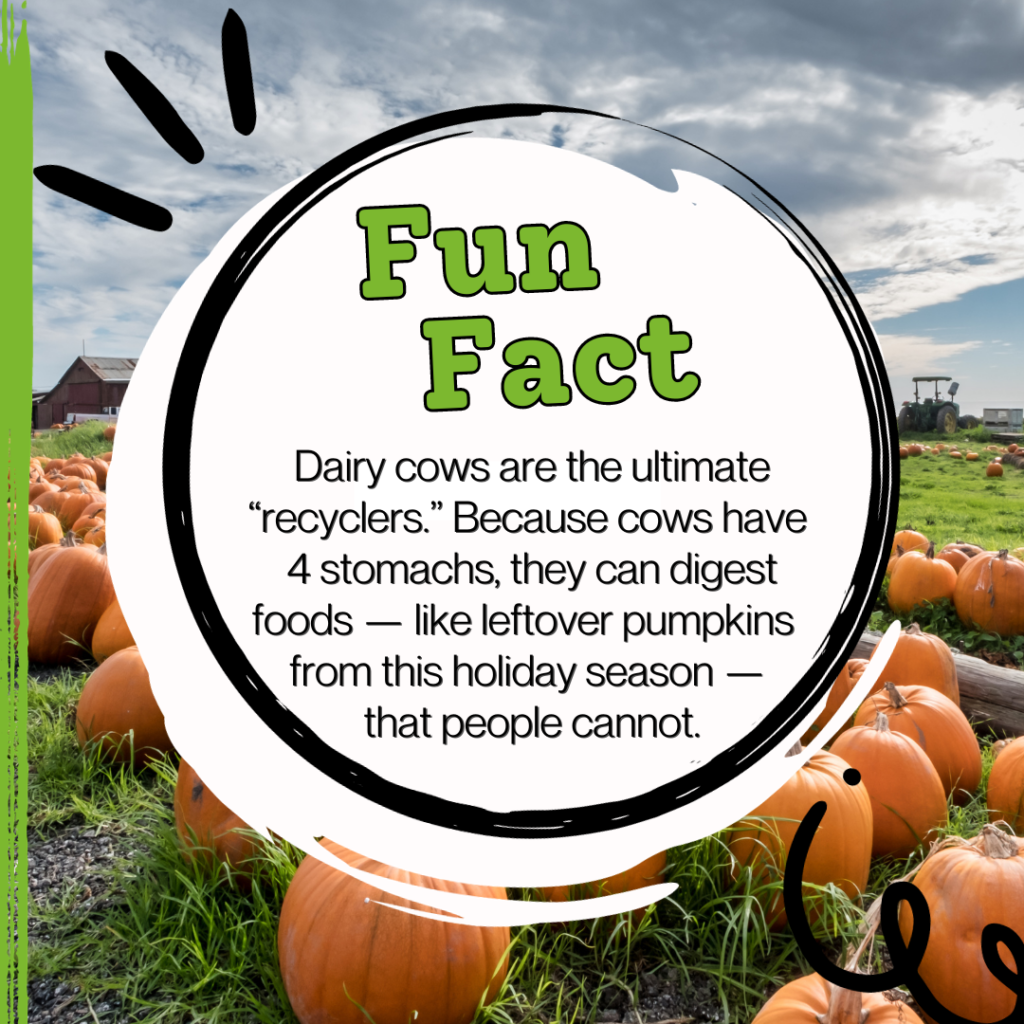
Cows and pumpkins are the perfect pairing because dairy cows are the ultimate “recyclers!” Because cows have four stomachs, it gives them the ability to digest foods — like leftover pumpkins — that people cannot, ensuring that an entire patch of pumpkins won’t go to waste at the end of the holiday season. In turn, the pumpkins provide many benefits to the cows and dairy farmers. Pumpkins are included in the cows’ feed, which also consists of corn silage, haylage and various grains. The pumpkins serve as a good supplemental protein and energy source for the cows. Because of those nutritional benefits, pumpkins also help to increase the cows’ milk production.
Apple Pie Sundae Recipe
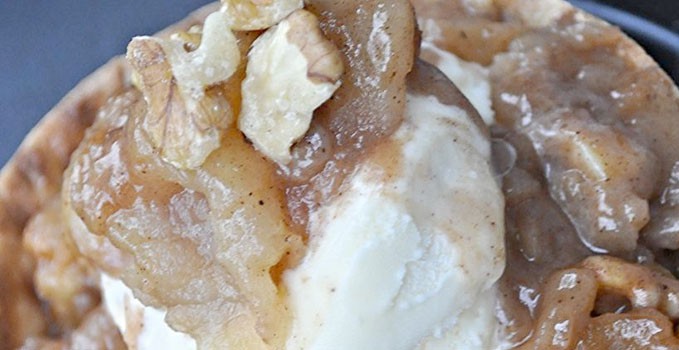
| This week, we have a delicious Apple Pie Sundae recipe for you. In addition to pumpkin pie, apple pie is often a staple at the Thanksgiving dessert table. Why not try something a little different with this sundae? Make sure to use real butter and enjoy it with your favorite vanilla ice cream. |
| Ingredients – 4 large apples, cored, peeled and sliced into 1/4 in. slices – ¼ cup butter – ½ cup chopped walnuts, a few reserved for garnish – ¼ cup packed brown sugar – 1 tsp lemon juice – ½ cup apple cider – 1 tbsp cornstarch – 1 tsp ground cinnamon – ⅛ tsp ground nutmeg – ⅛ tsp allspice – Vanilla Ice Cream – Waffle bowls Directions 1. Melt butter in a large skillet over low heat. 2. Add apples in a single layer. 3. Sprinkle with lemon juice, brown sugar and spices. 4. Stir to coat. 5. Cover and simmer on low until tender, about 10 minutes. 6. Remove apples with a slotted spoon. 7. In a small bowl, combine apple cider and cornstarch. Whisk well. 8. Pour into skillet with drippings from apples. 9. Increase heat to medium. 10. Whisk continuously until thickened. 11. Combine apples, sauce and walnuts in a large bowl. Stir gently to combine. 12. Allow to cool slightly. Scoop ice cream into waffle bowls, spoon apple mixture over top. Add a few walnuts to top. |